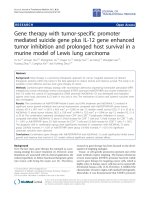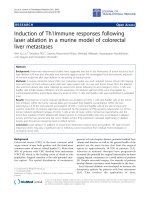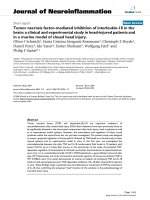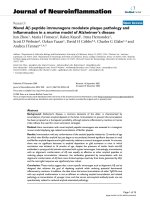Characterization of fetomaternal microchimerism in a murine model 1
Bạn đang xem bản rút gọn của tài liệu. Xem và tải ngay bản đầy đủ của tài liệu tại đây (4.67 MB, 183 trang )
CHARACTERIZATION OF FETOMATERNAL
MICROCHIMERISM IN A MURINE MODEL
YEO AILING
B.Sc. (Hons), NUS
A THESIS SUBMITTED
FOR THE DEGREE OF DOCTOR OF PHILOSOPHY
NUS GRADUATE SCHOOL FOR INTEGRATIVE
SCIENCES AND ENGINEERING
NATIONAL UNIVERSITY OF SINGAPORE
2012
i
ACKNOWLEDGEMENTS
Firstly, I would like to express my deepest gratitude to my former PhD supervisor, Dr.
Gerald Udolph for his kind advice, mentorship and the opportunity to work under him.
Secondly, I would like to express my utmost gratitude to my current PhD supervisor,
Dr. Jerry Chan, for his willingness to mentor the last few months of my PhD
candidature. I am grateful for all the help that I have received from him.
I would also like to express my appreciation to Dr. Simon Tan, for his infinite
patience and guidance provided even after he had left the lab. I am truly appreciative
of all the time and efforts that he has given to this project,
I would like to express my utmost graditute to the Executive Director of Institute of
Medical Biology (IMB), Prof Birgitte Lane and Senior Principle Investigators (PI),
Prof Barbara Knowles and Prof Davor Solter for providing me with temporary lab
space and facilities. Without them, I would not have been able to acquire the data
necessary to complete my thesis.
I would like to thank the fellow lab colleagues from Prof Davor Saltor and Prof
Barbara Knowles’ lab, especially Dr. Lim Chin Yan and Dr. Chanchao
Lorthongpanich for their kind advice and sharing expertise.
In addition, I would also like to thank my past and present laboratory colleagues
especially Wendy, Wanru and Joanne from Dr. Gerald Udolph’s Lab who have been
most helpful and have made my stay in the lab an enjoyable one.
I would like to thank Prof Michael Raghunath and Prof. Lim Sai Kiang for agreeing to
be part of my Thesis Advisory Committee members.
Most importantly, I am grateful to the A*Star Graduate Academy for providing this
opportunity to study in this field and their generous funding of this project.
Lastly, not forgetting my family and friends for their constant support throughout my
4 years of PhD studies.
ii
TABLE OF CONTENTS
ACKNOWLEDGEMENT i
TABLE OF CONTENTS ii
ABSTRACT iii
LIST OF TABLES v
LIST OF FIGURES vi
ABBREVIATIONS viii
CHAPTER 1: INTRODUCTION 1
CHAPTER 2: MATERIAL AND METHODS 19
CHAPTER 3: LONG TERM ENGRAFTMENT OF FETAL CELLS 37
CHAPTER 4: ORGAN-SPECIFIC DIFFERENTIATION OF FETAL CELLS 64
CHAPTER5: FETAL CELLS DERIVED FROM THE EMBRYO
PROPER AND THE NEUROECTODERMAL
LINEAGE INTEGRATE INTO MATERNAL TISSUES
AND ORGANS 75
CHAPTER 6: SINGLE CELL GENE EXPRESSION ANALYSIS OF
PERIPHERAL BLOOD FETAL CELLS 104
CHAPTER 7: DISCUSSION 122
CONCLUSION 149
REFERENCES 152
APPENDIX
iii
ABSTRACT
Fetal cells have been shown to transmigrate into the mother through the
placental interface during pregnancy and these cells can persist in various maternal
organs for as long as decades. In animal studies, it has been suggested that fetal cells
also termed pregnancy associated progenitor cells (PAPCs) might possess
multipotential differentiation capabilities. Therefore, fetal cells might have a
regenerative function that is potentially useful for cell-based therapies. However,
much needs to be learned about the basic biology of these fetal cells such as their
long-term homing, survival, integration and differentiation in maternal organs and the
origin and identity of these fetal cells.
The persistence of fetal cells in the maternal body led us to hypothesize that
these multipotential fetal cells that transmigrate into the maternal body originate from
the embryo proper. To test the hypothesis, a mouse model, which allows tagging of
fetal cells by the reporter, green fluorescent protein (GFP) for in-depth
characterization of fetal cells in healthy mothers was used. Using various methods
such as flow cytometry, qPCR and immunohistochemistry (IHC), a temporal profile
of fetal cells trafficking into maternal organs and blood at various pre- and post-natal
time points was established. Our data demonstrated that fetal cells were able to persist
into late adulthood suggesting long-term survival capabilities. The organ-specific
differentiation capability of fetal cells in two maternal organs was also studied. This
work showed that fetal cells could differentiate to neurons in the brain and to
epithelial and endothelial cell types in the lung.
iv
Next, genetic lineage tagging using the Cre-LoxP recombination technique
was done in order to elucidate the developmental origin of fetal cells from the fetus.
Meox2-cre and Nestin-cre mice were used to lineage tagged embryo proper and
neuroectodermal derivatives, respectively. The presence of embryo proper-tagged
fetal cells suggests an embryo proper origin rather than a trophectodermal origin.
Neuroectodermally-tagged fetal cells were found in the maternal blood and solid
organs such as lung and liver. Furthermore, neuroectodermally-tagged fetal cells
found in the maternal blood expressed the pan-haemopoietic marker CD45,
suggesting that these cells adopted a hematopoietic cell fate. These data provided
insight into fetal cells originating from the embryo proper and also potentially from
the neuroectodermal lineage. Lastly, using single cell gene expression analysis, it was
found that fetal cells could be grouped according to their gene signatures, which
suggests a diverse and mixed population of cell types transfer into mothers during
pregnancy with fetal cells with a neuroectodermal signature predominating. In
addition, changes in the temporal expression profile of some candidate genes such as
Oct4 and Runx1 were also observed.
In conclusion, this study suggests that fetal cells are able to integrate and
survive in maternal body long-term and acquire organ-specific cell fates in the lung,
blood and brain. Fetal cells possibly originate from the embryo proper and in
particular from the neuroectodermal lineage. Further work should focus on identifying
the differentiation capability and origin of fetal cells, which may provide further
knowledge, which could allow the translation of these intriguing cells into cell-
therapy, based clinical applications.
v
LIST OF TABLES
Table 1: List of antibodies used in the study.
Table 2: Primer sequences for genotyping and gene targets used in the study.
Table 3: Average number of GFP
+
fetal cells in maternal organs during and after
pregnancy by QPCR analysis.
Table 4: Quantification of GFP
+
fetal cells in maternal organs after pregnancy by
IHC analysis.
Table 5: List of selected target genes for the Fluidigm expression analysis.
vi
LIST OF FIGURES
Figure 1: ZGFP-floxed reporter strain expression construct.
Figure 2: Cre transgenic mouse line expression construct.
Figure 3: Quantification of GFP
+
fetal cells in maternal peripheral blood pre- and
post-natally.
Figure 4: Distribution of GFP
+
fetal cells at P0 assayed by qPCR.
Figure 5: Detection of fetal cells in different maternal organs by confocal
microscopy at P0
Figure 6: Long-term engraftment of fetal cells in maternal organs as detected by
qPCR.
Figure 7: Long-term engraftment of fetal cells in maternal organs as detected by
IHC.
Figure 8: Fetal cells were detected in maternal liver at long-term time points.
Figure 9: Detection of GFP
+
fetal cells in maternal kidney by IHC at long-term time.
Figure 10: Detection of GFP
+
fetal cells in maternal intestine by IHC at long-term.
Figure 11: Detection of GFP
+
fetal cells in maternal brain by IHC at long-term time.
Figure 12: Detection of GFP
+
fetal cells in maternal lung by IHC at long-term time.
Figure 13: Detection of GFP
+
fetal cells in maternal heart by IHC at long-term time.
Figure 14: Ki67 analysis of clusters of GFP
+
fetal cells found in P210.
Figure 15: Confocal images of brains at P30 mothers with Thy1-YFP
+
fetal cells.
Figure 16: Expression of CD141 on GFP
+
fetal cells in maternal lung.
Figure 17: Temporal analysis of CD31 expression (orange) of fetal cells (green)
found in the maternal lung.
Figure 18: Expression of CK19 (red) on fetal cells (green) in maternal lung.
vii
Figure 19: FACS analysis of PBMCs from positive (MZ
+/+
and GFP) and negative
(MZ
-/-
and WT) control animals.
Figure 20: Presence of GFP
+
MZ
+/+
fetal cells in maternal peripheral blood as
determined by flow cytometry.
Figure 21: Nestin-cre mediated GFP expression in E14.5 NZ
+/+
fetus.
Figure 22: Histogram of flow cytometry analysis of PBMCs of NZ
+/+
pups from
Nestin-cre;ZGFP-floxed mating.
Figure 23: Quantification of GFP
+
NZ
+/+
fetal cells in maternal blood as determined
by flow cytometry analysis.
Figure 24: Detection of neuroectodermally-tagged GFP
+
fetal cells (green) in P30
maternal brain.
Figure 25: Expression of neuronal marker MAP2 of neuroectodermally tagged GFP
+
fetal cells in P30 maternal brain.
Figure 26: Analysis of CD45 expression in P30 maternal blood.
Figure 27: Detection of GFP
+
NZ
+/+
fetal cells in maternal kidney by IHC.
Figure 28: Detection of GFP
+
NZ
+/+
fetal cells in the maternal liver by IHC.
Figure 29: Analysis of CD45 and CK19 expression of GFP
+
NZ
+/+
fetal cells in
maternal lung by IHC.
Figure 30: Analysis of CD45 expression of actin-GFP
+
labelled fetal cells in maternal
lung by IHC.
Figure 32: FACS analysis and sorting of PBMCs.
Figure 32: Heat map of transcript abundance of 16 genes analysed in 121 cells.
Figure 33: Frequency of gene expression of fetal cells from maternal circulation.
Figure 34: Representation of the frequency of fetal cells expressing selected target
genes singularly or in combination.
Figure 35: Number of fetal cells that expressed genes annotated to gene function.
Figure 36: Boxplot of transcript abundance of the genes that were highly enriched in
cells analysed at different gestational time points.
viii
ABBREVIATIONS
BM Bone marrow
BrdU 5-bromo-2'-deoxyuridine
CCl4 Carbon tetrachloride
cDNA Complementary DNA
CMV Cytomegalovirus
DAPI Diamidino-2-phenylindole
DNA Deoxyribonucleic acids
E Embryonic
EPCs Endothelial progenitor cells
FACS Fluorescence-activated cell sorting
FBS Fetal Bovine Serum
FMC Fetomaternal microchimerism
GFP Green fluorescent protein
GVHD Graft versus host disease
HSC Hematopoietic stem cells
ICM Inner cell mass
IHC Immunohistochemistry
IVS Intervillous space
LPS Lipopolysaccharies
MAP2 Microtubule-associated protein 2
MSC Mesenchymal stem cells
NTC Non template control
P Postpartum
PAPCs Pregnant associated progenitor cells
PFA Paraformaldehyde
PBMCs Peripheral blood mononuclear cells
PBS Phosphate buffered saline
PCR Polymerase chain reaction
qPCR Quantitative PCR
RBC Red blood cell
RT Reverse transcription
RT-PCR Real-time PCR
ix
SLE Systemic Lupus erythematosus
SP Side population
SSc Systemic Sclerosis
SSc Sjogrens Syndrome
STA Specific target amplification
WT Wild type
YFP Yellow fluorescent protein
1
CHAPTER 1:
INTRODUCTION
2
1.1. Definition of fetomaternal microchimerism
Microchimerism is a state in which minute numbers of genetically distinct
cells populate an individual of a different genotype. The state of microchimerism can
be acquired through blood transfusion, organ transplantation and pregnancy (Yunis et
al. 2007). Development of microchimerism as a result of pregnancy is known as
fetomaternal microchimerism (FMC), a well characterized phenomenon in placental
veterbrates (Liegeois et al. 1981; Jimenez et al. 2005). During pregnancy, a
genetically distinct fetus develops within the maternal body and is physically
dependent on maternal circulation for survival. Interestingly, small numbers of fetal
cells are found to transmigrate and persist in mothers years after delivery (Lapaire et
al. 2007). These fetal cells are believed to transmigrate into the maternal organs
possibly via the placenta, where fetal and maternal tissue physically interacts.
Transplacental passage of fetal cells has been studied and reported extensively
(Oudejans et al. 2003; DESAI and CREGER 1963; Walknowska et al. 1969;
Gänshirt-Ahlert et al. 1992). The presence of fetal cells in maternal bodies was first
reported in 1893 by Georg Schmorl (Schmorl 1893). Schmorl observed the presence
of multinucleated trophoblastic cells in the pulmonary arteries and hypothesized that
these cells were of fetal origin (Lapaire et al. 2007). Subsequently, other studies also
reported similar findings and confirmed the presence of fetal cells of trophoblastic
characteristics in maternal circulation (Mueller et al. 1990; Vernochet et al. 2007;
Guetta et al. 2005). In addition to trophoblasts, a wide range of cell types of fetal
origin was also found in the maternal circulation. Examples of such fetal cell types are
erythrocytes, nucleated erythrocytes (Schröder 1975; (Simpson and Elias 1993),
3
leukocytes (Herzenberg et al. 1979), hematopoietic stem cells (HSC) (Bianchi et al.
1996) and mesenchymal stem cells (MSC) (O'Donoghue et al. 2004) which can be
found in the maternal circulation during and after pregnancy. These fetal cells were
later termed pregnancy-associated progenitor cells (PAPCs) as these cells have been
shown to possess stem cell-like properties (Khosrotehrani and Bianchi 2005).
1.2. Detection of fetal cells in mothers
In human studies, Y-chromosome (Y-chr) has been utitlized as a marker to
identify male cells of fetal origin in a female host. The Y-chr can be detected using
PCR and fluorescent in-situ hybridization (FISH). The amplification of Y-chr DNA
has a sensitivity of one male fetal cell in a background of 10
5
maternal cells (Yan et al.
2005). FISH detection of fetal cells involves the use of chromosome-specific probes
for Y-chr and allows visualization of Y-chr bearing cells and has the sensitivity of one
XY cell per 10
5
to 2 x 10
5
cells (Krabchi et al. 2006). However, there are issues with
regards to using Y-chr as marker for male fetal cells in fetomaternal microchimerism.
The use of Y-chr is also only applicable to pregnancies with a male fetus and
does not reflect the contribution of fetal cells from female fetuses. In addition, the
presence of Y-chr can also be detected in women with no history of a male birth (Yan
et al. 2005). The possible reasons given for such observations could be due to (1)
unknown miscarriage of a male fetus; (2) a vanished male twin which was reabsorbed
by the mother (Sato et al. 2008); and (3) transfer of a women’s older brother’s cells
from maternal circulation (Guettier et al. 2005).
4
The study of fetomaternal microchimerism in human samples has its
limitations. In human studies, lack of precise knowledge of pregnancy history and
access to maternal tissues has hampered progress in understanding FMC (Bianchi
2007). Therefore, using a mouse model could possibly circumvent some of the issues
faced in human studies. Although mice have a different form of placentation than
humans, it is still comparable and the use of mouse models in the study of
fetomaternal microchimerism has several advantages (Georgiades et al. 2002).
First, with mice one can have precise knowledge of the pregnancy history by
controlling the mating process. Second, the wide range of transgenic mice that are
available would enable various aspects of fetomaternal microchimerism to be studied,
which otherwise not be possible in humans. Mice containing transgenic reporter genes,
such as GFP, have allowed the tracking of cells of fetal origin in maternal tissue.
Moreover, specific transgenic mice with lineage specific promoters can provide
information regarding the differentiation ability and function of these fetal cells in
mothers. For example, the VEGFR2-Luciferase reporter line has been used to study
angiogenesis capabilities of fetal cells in mothers (Nguyen Huu et al. 2007) and the
Thy1-YFP reporter line has been used to study if fetal cells can become mature
neurons in maternal brain (Zeng et al. 2010). Furthermore, a larger number of fetal
cells transferred can be achieved using transgenic mice of the same genetic
background, which is not possible in human studies. The relationship between
maternal genetic background and level of FMC were studied using various mouse
models and shown to have an effect on the fetal cell trafficking into the maternal body.
Moreover, the frequency of FMC was found to be higher in females from syngeneic
5
and congenic than allogenic matings (Bonney and Matzinger 1997; Khosrotehrani et
al. 2005).
1.3. Trafficking and persistence of fetal cells in mothers
The presence of male fetal cells was first determined in the peripheral blood of
healthy pregnant woman. These cells were detected using antibody to a paternal
HLA-cell surface antigen and were enriched using both fluorescence-activated cell
sorting (FACS) and microscopic analysis to confirm the presence of the Y-chr
(Herzenberg et al. 1979). The kinetics of fetal cell trafficking into maternal circulation
in healthy women without pregnancy complications was also studied. The results
showed that a low level of fetal cells is present in the early gestational period, which
started to increase from week 24 onwards, peaking at parturition. Other studies also
supported the observation that the level of fetal cells and/or cell-free DNA increased
in maternal circulation as pregnancy progressed (Lo et al. 1990; Bianchi et al. 1997).
However, the level of fetal cells declined rapidly after delivery (Ariga et al. 2001).
Indeed, male apoptotic cells were found in the circulation of all females pregnant with
male fetuses at 38 weeks of gestation. The proportion of male apoptotic cells in
maternal circulation increased at 30 minutes after delivery with none detected at 48
hours post delivery thus suggesting that fetal cells were cleared from maternal
circulation rapidly after delivery (Kolialexi et al. 2004).
Animal models were developed to study FMC. In one study, Fujiki et al (2008)
investigated the traffiicking of fetal cells in healthy mice during and shortly after
pregnancy. Similar to the observations in human studies fetal cells could be detected
6
as early as E6.0 in the murine pregnancy. The levels of fetal cells continued to
increase and peaked at E19.0 then decreased rapidly after postpartum (Fujiki et al.
2008; Sunami et al. 2010). The traffiicking of fetal cells into maternal organs as early
as E6.0 suggests that fetal cells could enter the maternal body even when placental
circulation has not yet developed in pregnant mice (Sunami et al. 2010).
The level of FMC was found to increase in pregnancy disorders such as pre-
eclampsia. As early as 1893, Schmorl has demonstrated significant differences in the
number of fetal cells in mothers with normal pregnancies and those afflicted with
eclampsia (Lapaire et al. 2007). With the use of more advanced technology in recent
studies, the Schmorl findings were confirmed. It was found that the number of fetal
cells was higher in women with pre-eclampsia conditions as compared to matched
controls (Holzgreve et al. 1998). In addition to abnormalities, an increase in the
transfer of fetal cells and DNA into the maternal circulation was observed as a
consequence of elective or spontaneous fetal loss. These studies also demonstrated
that women were able to acquired FMC even when the fetuses were aborted as early
as the first and second trimester (Bianchi et al. 2001; Khosrotehrani et al. 2003).
Using a mouse model, when lipopolysaccharide (LPS) was injected into day 14
pregnant mice to induce the termination of pregnancy and higher frequency of fetal
cells were found in the maternal lung. This study confirmed the observation that in
human studies significant fetomaternal hemorrhage due to termination of pregnancy
results in higher fetal cell trafficking into the maternal body (Johnson et al. 2010).
The persistence of fetal cells in maternal organs was first demonstrated in
1996 when male fetal cells were found in the peripheral blood of a healthy woman
7
who had last given birth to a son 27 years previously (Bianchi et al. 1996). A
subsequent study also demonstrated the long term persistence of such fetal cells in
maternal circulation with the longest determined to be 57 years after the last
pregnancy (Ichinohe et al. 2005). The persistence of fetal cells in mothers is often
studied in human subjects with clinical manifestations. The persistence of fetal cells
has been demonstrated in a wide range of organs in patients, including the liver
(Stevens et al. 2004), lung (O'Donoghue et al. 2008), thyroid (Klintschar et al. 2001 &
2006) and skin (Artlett et al. 1998). However, fetal cells are also found in healthy
women long after pregnancy even in the maternal circulation thus indicating its ability
to persist in healthy individuals as well (Bianchi et al. 1996; Evans et al. 1999). In
mouse models, studies were often done to study the short-term presence and effect of
fetal cells in diseased or injury models. The targeted maternal organs were usually
collected and analyzed during embryonic stages (Nguyen Huu et al. 2007; Nguyen
Huu et al. 2009) or a few days after delivery (Zhong and Weiner 2007). The longest
study was done to study the presence of fetal cells at nine months postpartum in
previously pregnant female mice with skin tumors (Nguyen Huu et al. 2008).
However, none of these studies looked into the long-term engraftment of the fetal
cells that had transmigrated into the normal healthy maternal system.
1.4. Persistence of FMC and autoimmune diseases
An association between FMC and autoimmune diseases was suggested based
on the observation that certain autoimmune diseases affect women with higher
frequency than men, and on the increased incidence of the diseases after pregnancy
(Nelson 1996). It was therefore hypothesized that these fetal cells contribute to the
8
pathogenesis of autoimmune diseases due to the graft-versus-host disease (GVHD)
like immune response against the fetal cells. Several studies have shown an
association between FMC and autoimmune diseases with higher number of fetal cells
found in the region of pathology as compared to sample from same region in healthy
women (Endo et al. 2002; Ando et al. 2002; Klintschar et al. 2001). One of the most
well studied autoimmune diseases in which fetal cells were implicated is systemic
sclerosis (SSc) as FMC was more prevalent in affected women than healthy controls
(Lambert et al. 2002). Fetal cells have been isolated from blood and active lesions
from systemic sclerosis patients and it was then demonstrated that these patients had a
higher population of CD4+ fetal cells than CD8+ fetal cells which also expressed
CD3 and were mainly of TH2 in origin (Artlett et al. 1998; Artlett et al. 2002; Scaletti
et al. 2002), suggesting a role in pathogenesis of diseases as these cells might be
reactive against the maternal host.
Functional studies were carried out and the findings corroborated the role of
FMC in disease pathogenesis. PBMCs were isolated from SSc patients and healthy
controls and were subjected to CD28 stimulation ex vivo. The stimulation resulted in
an increase in the amount of FMC from SSc patients but not from healthy controls
(Burastero et al. 2003). Furthermore, another study demonstrated that the T-cell
clones expanded from women with SSc were self-reactive and that 19% of the clones
were of male origin (Scaletti et al. 2002). However, it remained a possibility that in
the diseased state the fetal cells were already primed and therefore was able to
become reactive or to expand in response to the stimulation ex vivo.









